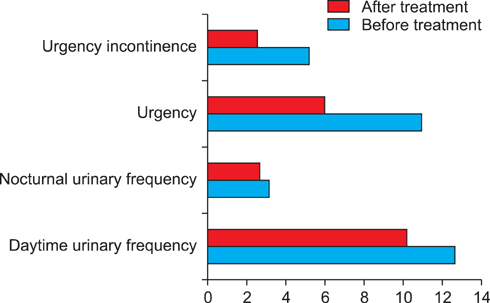Korean J Urol.
2012 Jul;53(7):483-486. 10.4111/kju.2012.53.7.483.
Clinical Efficacy in the Treatment of Overactive Bladder Refractory to Anticholinergics by Posterior Tibial Nerve Stimulation
- Affiliations
-
- 1Department of Urology, San Cecilio University Hospital, Granada, Spain. arrabalp@ono.com
- KMID: 1988760
- DOI: http://doi.org/10.4111/kju.2012.53.7.483
Abstract
- PURPOSE
Overactive bladder (OAB) is a clinical syndrome that is currently treated initially with anticholinergics, although some other therapeutic alternatives exist, such as neuromodulation, botulinum toxin, and posterior tibial nerve stimulation (PTNS). The purpose of this study was to assess the efficacy of PTNS in patients with OAB refractory to anticholinergics.
MATERIALS AND METHODS
We present a cohort study of 14 women with OAB to whom we applied PTNS. We assessed (before and after the treatment) the diurnal micturitional frequency, the nocturnal micturitional frequency, urgency episodes, and urge incontinence episodes. Results were analyzed by using the Wilcoxon test for nonparametric samples.
RESULTS
We observed statistically significant improvement in the diurnal micturitional frequency (p=0.05), in episodes of micturitional urgency (p=0.03), and in episodes of urge incontinence (p=0.004). A total of 50% of the patients felt subjective improvement from their pathology.
CONCLUSIONS
PTNS is a valid, minimally invasive treatment option with minimum morbidity for patients with OAB refractory to treatment with anticholinergics.
MeSH Terms
Figure
Reference
-
1. Abrams P, Cardozo L, Fall M, Griffiths D, Rosier P, Ulmsten U, et al. The standardisation of terminology of lower urinary tract function: report from the Standardisation Sub-committee of the International Continence Society. Neurourol Urodyn. 2002. 21:167–178.2. Milsom I, Abrams P, Cardozo L, Roberts RG, Thuroff J, Wein AJ. How widespread are the symptoms of an overactive bladder and how are they managed? A population-based prevalence study. BJU Int. 2001. 87:760–766.3. Stewart WF, Van Rooyen JB, Cundiff GW, Abrams P, Herzog AR, Corey R, et al. Prevalence and burden of overactive bladder in the United States. World J Urol. 2003. 20:327–336.4. Irwin DE, Milsom I, Hunskaar S, Reilly K, Kopp Z, Herschorn S, et al. Population-based survey of urinary incontinence, overactive bladder, and other lower urinary tract symptoms in five countries: results of the EPIC study. Eur Urol. 2006. 50:1306–1314.5. Andersson KE, Wein AJ. Pharmacology of the lower urinary tract: basis for current and future treatments of urinary incontinence. Pharmacol Rev. 2004. 56:581–631.6. D'Souza AO, Smith MJ, Miller LA, Doyle J, Ariely R. Persistence, adherence, and switch rates among extended-release and immediate-release overactive bladder medications in a regional managed care plan. J Manag Care Pharm. 2008. 14:291–301.7. Le NB, Kim JH. Expanding the role of neuromodulation for overactive bladder: new indications and alternatives to delivery. Curr Bladder Dysfunct Rep. 2011. 6:25–30.8. Garcia Matres MJ, Brenes Bermudez FJ. Diagnosis and management of patients with overactive bladder syndrome in urology clinics and general practitioner clinics in Spain. Arch Esp Urol. 2007. 60:15–21.9. Castro D, Miranda P, Sanchez-Ballester F, Arumi D, Lizarraga I, Ebel C, et al. Assessment of reasons for overactive bladder treatment change. Actas Urol Esp. 2011. 35:73–79.10. Benner JS, Nichol MB, Rovner ES, Jumadilova Z, Alvir J, Hussein M, et al. Patient-reported reasons for discontinuing overactive bladder medication. BJU Int. 2010. 105:1276–1282.11. Martinez-Agullo E, Ruiz-Cerda JL, Arlandis S, Rebollo P, Perez M, Chaves J, et al. Analysis of overactive bladder and urinary incontinence in working women aged between 25 and 64 years. EPICC study. Actas Urol Esp. 2010. 34:618–624.12. McGuire EJ, Zhang SC, Horwinski ER, Lytton B. Treatment of motor and sensory detrusor instability by electrical stimulation. J Urol. 1983. 129:78–79.13. Stoller M. Afferent nerve stimulation for pelvic floor dysfunction. Eur Urol. 2000. 37:33.14. Bellette PO, Rodrigues-Palma PC, Hermann V, Riccetto C, Bigozzi M, Olivares JM. Posterior tibial nerve stimulation in the management of overactive bladder: a prospective and controlled study. Actas Urol Esp. 2009. 33:58–63.15. Amarenco G, Ismael SS, Even-Schneider A, Raibaut P, Demaille-Wlodyka S, Parratte B, et al. Urodynamic effect of acute transcutaneous posterior tibial nerve stimulation in overactive bladder. J Urol. 2003. 169:2210–2215.16. Peters KM, Macdiarmid SA, Wooldridge LS, Leong FC, Shobeiri SA, Rovner ES, et al. Randomized trial of percutaneous tibial nerve stimulation versus extended-release tolterodine: results from the overactive bladder innovative therapy trial. J Urol. 2009. 182:1055–1061.17. Yoong W, Ridout AE, Damodaram M, Dadswell R. Neuromodulative treatment with percutaneous tibial nerve stimulation for intractable detrusor instability: outcomes following a shortened 6-week protocol. BJU Int. 2010. 106:1673–1676.18. Vandoninck V, van Balken MR, Finazzi Agro E, Petta F, Micali F, Heesakkers JP, et al. Percutaneous tibial nerve stimulation in the treatment of overactive bladder: urodynamic data. Neurourol Urodyn. 2003. 22:227–232.19. Finazzi-Agro E, Petta F, Sciobica F, Pasqualetti P, Musco S, Bove P. Percutaneous tibial nerve stimulation effects on detrusor overactivity incontinence are not due to a placebo effect: a randomized, double-blind, placebo controlled trial. J Urol. 2010. 184:2001–2006.20. MacDiarmid SA, Peters KM, Shobeiri SA, Wooldridge LS, Rovner ES, Leong FC, et al. Long-term durability of percutaneous tibial nerve stimulation for the treatment of overactive bladder. J Urol. 2010. 183:234–240.21. van der Pal F, van Balken MR, Heesakkers JP, Debruyne FM, Bemelmans BL. Percutaneous tibial nerve stimulation in the treatment of refractory overactive bladder syndrome: is maintenance treatment necessary? BJU Int. 2006. 97:547–550.
- Full Text Links
- Actions
-
Cited
- CITED
-
- Close
- Share
- Similar articles
-
- Current opinion of the treatment of female voiding dysfunction
- Transcutaneous Electrical Stimulation of the Abdomen, Ear, and Tibial Nerve Modulates Bladder Contraction in a Rat Detrusor Overactivity Model: A Pilot Study
- Do Failure of Posterior Tibial Nerve Stimulation Precludes to Use Sacral Neuromodulation in Patient With Overactive Bladder?
- Electrical Stimulation for Refractory Overactive Bladder
- Frequency-Dependent Effects on Bladder Reflex by Saphenous Nerve Stimulation and a Possible Action Mechanism of Tibial Nerve Stimulation in Cats


